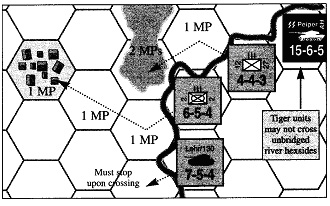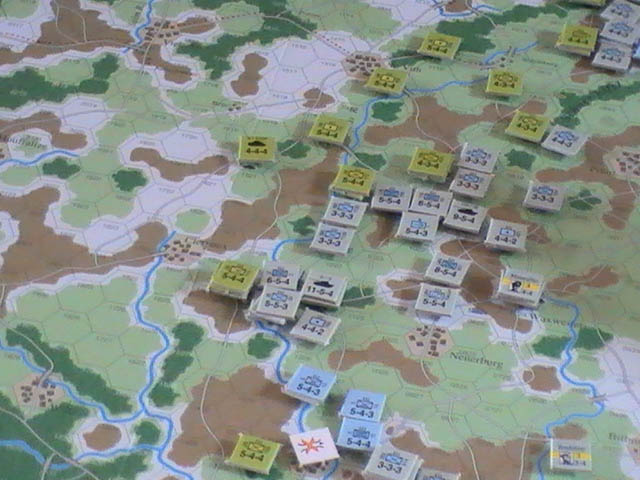| Bitter
Woods is a mid-complexity wargame on the last great German offensive in Dec 1944,
commonly known as the "Battle of the Bulge". The map depicts the area
of operations, the Ardennes area at the borders of Germany, France, Belgium, and
Luxemberg. Prominent features like roads, rivers and cities are depicted. A hexagonal
grid is superimposed over the map to regulate game play. Each hexagon is 2 miles
across, unit size is brigade and regiments. Each turn represents 12 hours of real
time. Game features
include morale, prominent leaders, blitzkrieg tactics, German army boundaries,
initial surprise, Allied air power and much more. Game
components include one 22 x 32" unmounted map, 320 counters including markers,
16-page rulebook. The
game was originally published by Avalon Hill. The second edition is published
by Multi-Man Publishing. PREPARE
FOR PLAY
The Allied player controls elements of the U.S. and British
Armies, and aircraft units. The German player controls all German Army, SS, Luftwaffe
ground units, and aircraft units. Players place their "At Start" units
on the map in accordance with their respective Order of Appearance Cards. The
remaining unit counters are reinforcements that enter the game on the game-turn
specified. After completing set-up, play may begin.
SEQUENCE OF PLAY
Each
game-turn consists of a German Player Turn and an Allied Player Turn. The sequence
of each game-turn must be strictly followed.
A.
GERMAN PLAYER TURN
1.
Mutual Supply Phase: Each player checks the supply status for all of his units
in play (rule 12).
2. German Reserve Phase: German mechanized units may be
placed in reserve (14.1).
3. Allied Interdiction Phase: The Allied player places
any available air units to interrupt German movement (11.3).
4. German Movement
Phase: The German player may conduct movement (rule 5), build improved positions
(8.1) and begin to repair bridges (13.3). Any German reinforcements scheduled
to arrive this turn may enter play at this time.
5. German Combat and Demolition
Phase: The German player conducts combat (rule 9) in any order desired. Bridges
may be blown at the end of this phase (13.1).
6. German Mechanized Exploitation
Phase: German mechanized units placed in reserve (rule 14) may move their full
movement allowance.
7. German Bridge Construction Phase: Bridge construction
may be completed at this time.
B.
ALLIED PLAYER TURN
The
Allied Player turn is identical to the German Player Turn (switching the term
German for Allied), except for the following differences:
· There is
no German Air Interdiction Phase.
· The Allied player may also build
fortifications during his movement phase.
· The Allied player may perform
air drops (12.5) during the mutual supply phase of his Player Turn.
C. RECORD
KEEPING PHASE
Record the completion of a game-turn by advancing the Game Turn
Marker one box along the Game Turn Record Track.
MOVEMENT
5.1
Procedure
During the appropriate movement phase, a player may move as many
or as few units as desired. Units are moved from hex to adjacent hex. A hex may
never be skipped or jumped. A friend
ly unit may never move through or end
movement in a hex occupied by an enemy unit.
5.2 Movement Allowances
Each
ground unit has a "movement allowance" printed on the counter. This
allowance is the maximum number of movement points (MPs) that may be expended
during the movement phase. As each unit enters a hex, the unit expends MPs from
its movement allowance. Unused MPs may not be accumulated from game-turn to game-turn,
nor may they be transferred to other units.
GUARANTEED ONE HEX MOVEMENT: A
unit may always move at least one hex regardless of the movement cost as long
as the movement is not into prohibited terrain, nor across prohibited hexsides,
nor from one hex in the ZOC of an enemy unit directly to another hex in the ZOC
of the same enemy unit (exception, bridge construction, rule 13).
5.3 Terrain
Effects on Movement
The Terrain Effects Chart located on the map identifies
the types of terrain and the costs incurred when moving into each type. Units
expend MPs based on the terrain of the hex entered as explained below:
·
Roads: Road movement is accomplished by moving units through connecting road hexes.
The road movement rate (except for German infantry and German artillery) is onefourth
of a movement point (1/4 MP) per hex entered, regardless of the other terrain
in the hex or connecting hexside. German infantry and German artillery have a
road movement rate of 1/3 MP per hex entered.
*Forest: All units (except those
with an armor silhouette) entering a hex containing a forest expend two MPs; those
units with an armor silhouette are allowed in forest hexes only on roads, and
they can enter and leave forest hexes only along the path of a road. Example:
armor units may only exit hex 0812 by moving directly into hex 0912.
·
Broken: Units entering a broken terrain hex expend two MPs. Broken terrain depicts
rolling hilly ground with occasionally steep draws near running bodies of water.
·
Town: All units entering a town hex expend only one MP.
· Light Woods:
Non-mechanized units entering a light woods hex expend only one MP; mechanized
and artillery units expend two MPs. A ground freeze occurs beginning with the
23AM December game-turn. At this time, all units entering a light woods hex expend
only one MP.
· Clear: Units entering a clear hex expend only one MP.
Mud conditions exist on the December 18AM through 19PM game-turns.

Various examples of crossing a river hexside.
During these turns, mechanized and artillery units entering a clear hex expend
2 MPs.
· River Hexside: Units may not cross an unbridged river hexside
unless they began their movement next to a river hexside and their first move
is to cross that river hexside (exception, Panther, Tiger, or Jagdtiger units
may never cross unbridged river hexsides). An infantry or armored infantry unit
that begins its turn next to a river hexside may cross that river hexside and
continue movement without penalty. Armor, armored cavalry and artillery units
that start their turn next to a river hexside may cross that river hexside and
end their movement (they may proceed moving on the following turn).
·
The Meuse: Armor, armored cavalry, and artillery units may cross a Meuse River
hexside only at a bridge. An infantry or armored infantry unit that begins its
turn next to an unbridged Meuse River hexside may cross that river hexside and
end its movement. The unit may proceed the following turn.
5.4
Army Boundaries
For the first three days (six game-turns), mechanized units
of the 5th Panzer Army and 6th Panzer Army may not violate each other's army boundaries.
In effect, mechanized units of the 6th Panzer Army may not attack into, move into,
or move south of the road beginning at hex 0915 and ending at hex 2417. Mechanized
units of the 5th Panzer Army may move along this road and attack out of it, but
may not move north of the road. Mechanized units of both armies may use the road
from 0714 to 0914 (inclusive). Army boundary restrictions are removed beginning
with the 19AM game-turn.
5.5 Exiting the Map
German mechanized units may
exit the map only from road hexes across the Meuse River on the western and northern
map edges. Exiting the map is calculated at the road movement rate. Allied units
with no other retreat route other than off the northern, southern, or western
map edges, and out of supply Allied units that voluntarily exit the northern,
southern, or western map edges may return to the game along the same map edge
on any road hex containing a boxed letter by remaining off the map for at least
one complete game-turn and entering during any subsequent game-turn. For purposes
of retreat, German ZOCs extend off the map edge so that retreating Allied units
forced to exit the map may be eliminated. Towns bordering the map edges are considered
to have a road leading off the map.
|

